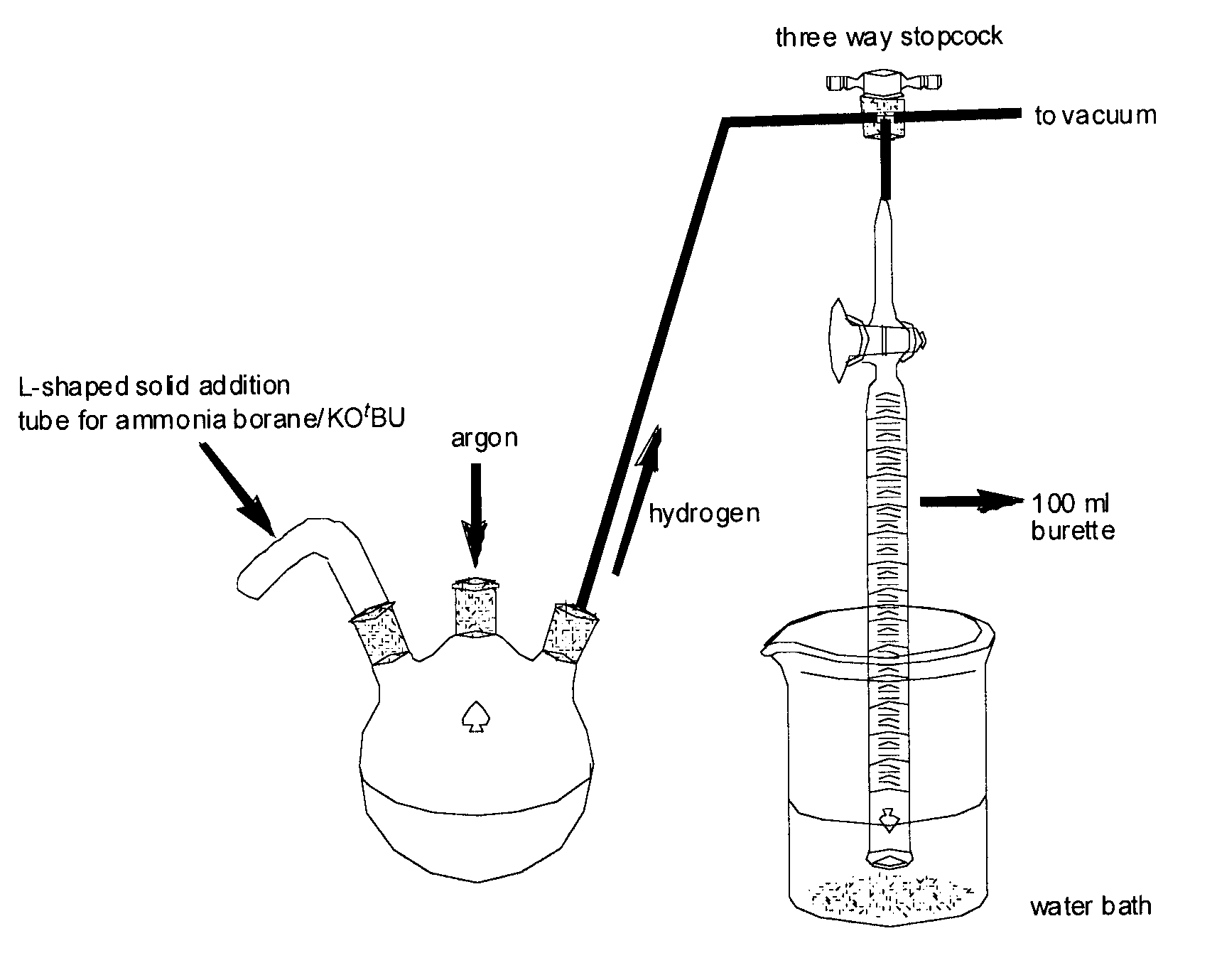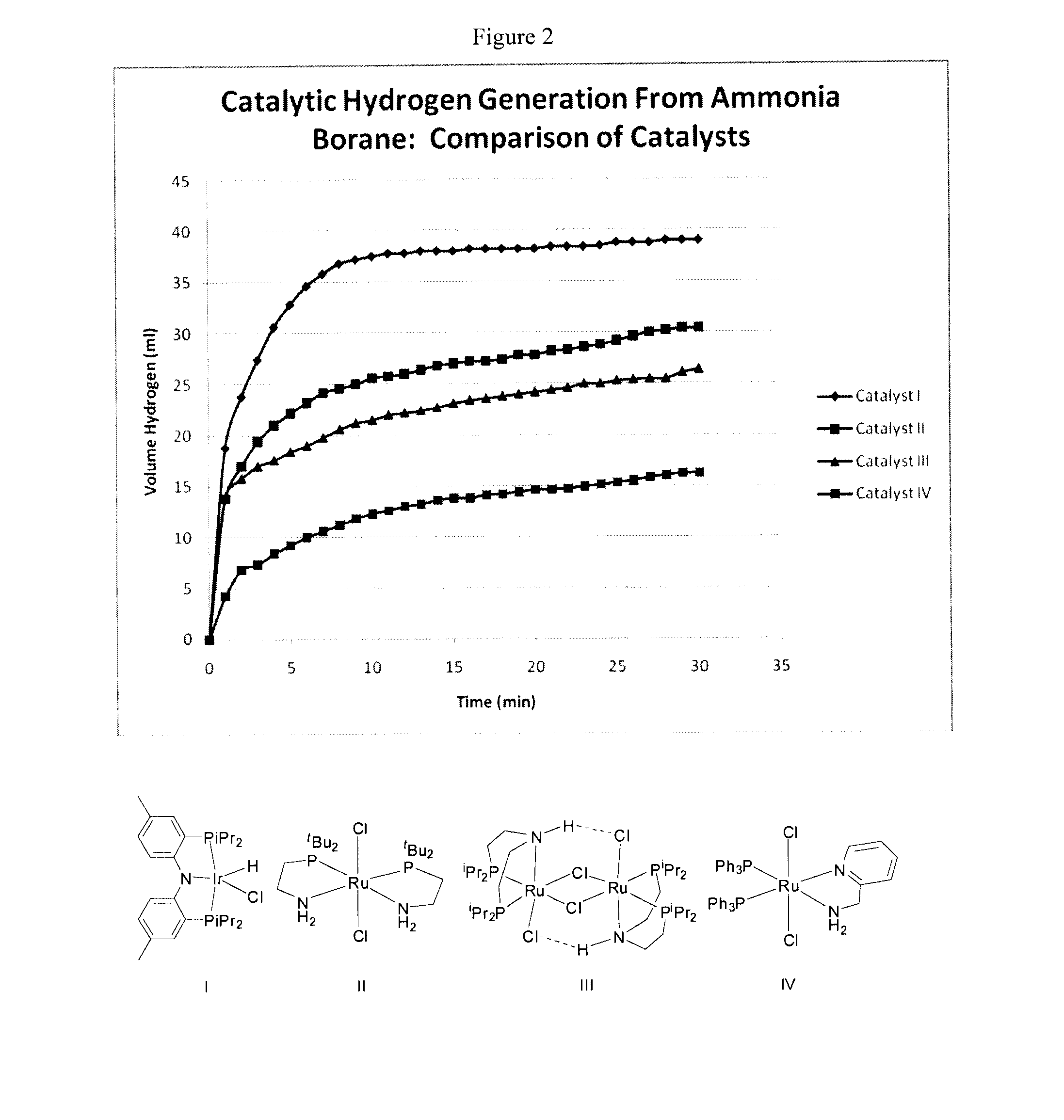Method for the production of hydrogen from the dehydrocoupling of amine boranes
a technology of amine boranes and hydrogen, which is applied in the field of metal-catalyzed dehydrocoupling of amine boranes, can solve the problems of limiting the potential widespread and large-scale use of hydrogen, affecting the use of hydrogen as a fuel, and causing severe environmental problems
- Summary
- Abstract
- Description
- Claims
- Application Information
AI Technical Summary
Problems solved by technology
Method used
Image
Examples
experimental examples
Materials and Methods
[0117]All ligands and their metal complexes were prepared under an argon atmosphere in an Innovative Technologies inert atmosphere glovebox or with standard Schlenk techniques, unless otherwise stated. Ammonia borane was obtained from Boroscience Ltd, or was prepared according to a literature procedure (Ramachadran, P. V.; Gagare, P. D. Inorg. Chem. 2007, 46, 7810-7817). Ruthenium(III) chloride hydrate (RuCl3.3H2O) was obtained from Pressure Chemicals Company. 1,5-Cyclooctadiene-2,4-pentanedionaterhodium(I) [Rh(COD)(acac)], and chlorobis(cyclooctene)iridium(I) dimer ([Ir(COE)2Cl]2) were obtained from Colonial Metals Inc. Chlorobis(1,5-cyclooctadiene)rhodium(I) dimer was obtained from Strem Chemicals. Dichloro-1,5-cyclooctadienepalladium(II) (Pd(COD)Cl2) was prepared using standard procedures. All other metal salts were obtained from Sigma-Aldrich Ltd. and were used as received. Dichloromethane, diethyl ether, hexanes, tetrahydrofuran and toluene were dried and d...
example 1
Standard Dehydrocoupling Reaction Conditions
(a) Chlorohydridobis(2-(diisopropylphosphino)-4-methylphenyl)amido iridium(III) Catalyzed ammonia borane Dehydrocoupling
[0118]
[0119]A 50.4 mg (1.632 mmol) sample of ammonia borane and 30.7 mg (0.275 mmol) of potassium tertiary butoxide was added to an L-shaped solid addition tube, which was then connected to a 100 ml three-necked flask which contained 9.8 mg (0.0156 mmol) of chlorohydridobis(2-(diisopropylphosphino)-4-methylphenyl)amidoiridium (III). The flask was placed under an argon atmosphere and then 25 ml of dried, degassed tetrahydrofuran was added. The mixture was then placed in a water bath that was heated to 40.7° C. and the temperature was allowed to equilibrate for ca. five minutes. The ammonia borane and potassium tertiary butoxide were added by inverting the reaction vessel to allow the solvent to wash the solids into the reaction mixture. The flask was then placed back into the water bath and gas evolution occurred.
[0120]All...
example 2
Hydrogen Measurement Experiments
[0121]The reactions were performed under an argon atmosphere in a 3-necked round bottom flask that was connected to a calibrated 100 ml burette (FIG. 1) and a standard vacuum manifold using the conditions described in Example 1. The ammonia borane and potassium tertiary butoxide were added via an L-shaped solid addition tube and the evolved gas was measured at one minute intervals.
(a) Chlorohydridobis(2-(diisopropylphosphino)-4-methylphenyl)amido iridium(III) Catalyzed ammonia borane Dehydrocoupling
[0122]
[0123]Reagent amounts were as described in Example 1(a). The results are provided in Table 2 and are shown graphically in FIG. 2 (Catalyst I).
(b) Dichloro-2-(ditertiarybutylphosphino)ethanamine ruthenium(II) Catalyzed ammonia borane Dehydrocoupling
[0124]
[0125]Amount of compounds: catalyst (7.8 mg, 0.014 mmol) ammonia borane (50.8 mg, 1.646 mmol); potassium tertiarybutoxide (29.8 mg, 0.266 mmol). Temperature: 40.0° C. The results are provided in Table ...
PUM
| Property | Measurement | Unit |
|---|---|---|
| pressures | aaaaa | aaaaa |
| temperature | aaaaa | aaaaa |
| temperature | aaaaa | aaaaa |
Abstract
Description
Claims
Application Information
 Login to View More
Login to View More - R&D
- Intellectual Property
- Life Sciences
- Materials
- Tech Scout
- Unparalleled Data Quality
- Higher Quality Content
- 60% Fewer Hallucinations
Browse by: Latest US Patents, China's latest patents, Technical Efficacy Thesaurus, Application Domain, Technology Topic, Popular Technical Reports.
© 2025 PatSnap. All rights reserved.Legal|Privacy policy|Modern Slavery Act Transparency Statement|Sitemap|About US| Contact US: help@patsnap.com



